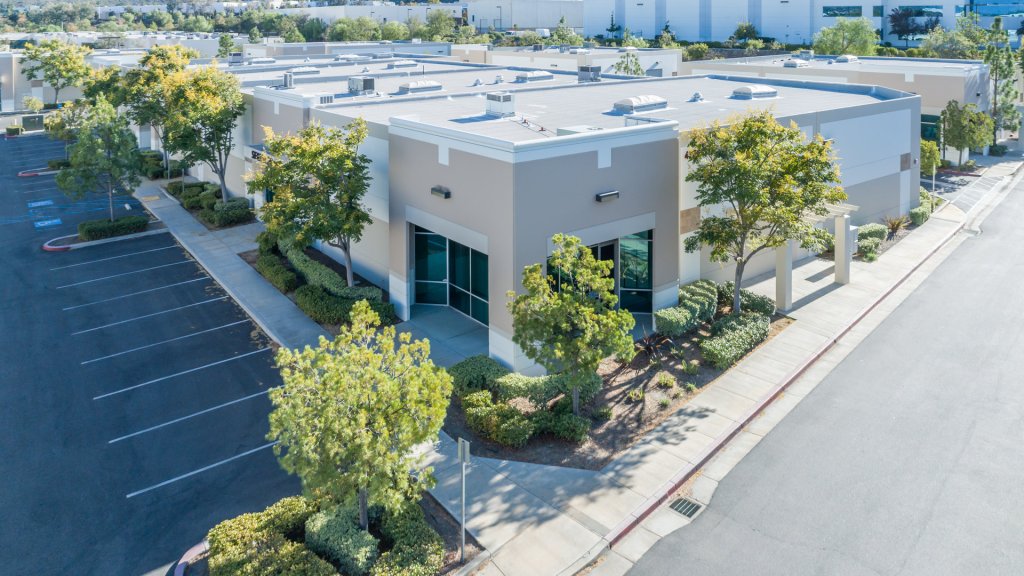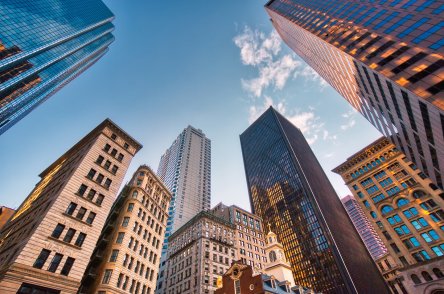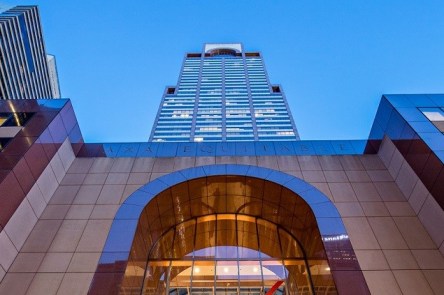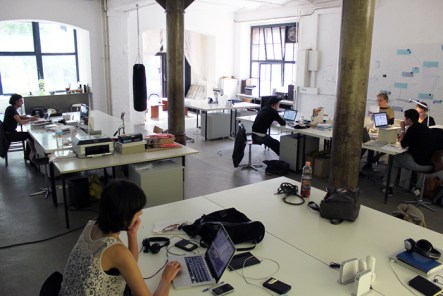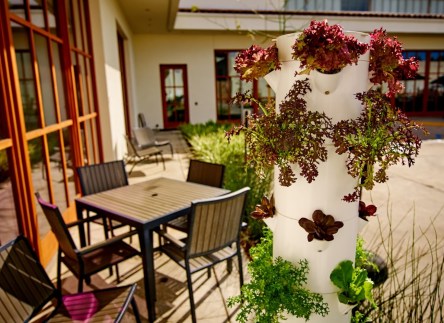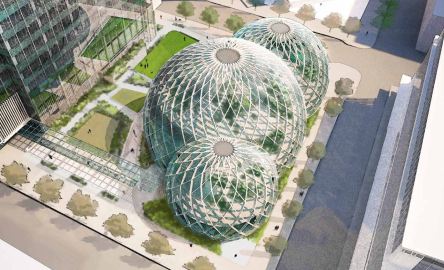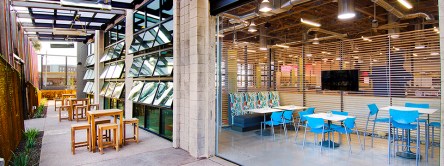Yardi Matrix continued its series of comprehensive market impact webinars on May 13 with an in-depth look at the state of the commercial real estate industry, presented by Jeff Adler, vice president of Matrix, and Rob Teel, senior vice president of global solutions at Yardi. Both provided data and insight into the crucial question Adler introduced at the start of the session: How do we move forward, past the lockdown and into the recovery phase? “Despite the herculean efforts by the federal government to keep businesses afloat, there is still more pain to come,” Adler said. And for each sector of commercial real estate, the road ahead will look different. Optimistic outlook for industrial Across all real estate sectors, industrial and multifamily are holding up best during the COVID-19 pandemic. “They were also the two best performing sectors before this hit,” Adler noted. April rent collections for industrial averaged around 86-87 percent, so the sector is not entirely immune to nonpayment, but looks good compared to retail. Dependence on e-commerce for home-delivered supplies and other purchases has helped industrial stay stable. In some smaller markets ideal for last-mile delivery siting, industrial rents are even edging up. There’s also newfound demand for cold storage due to changes in the grocery market. Office holding up, but changes expected All things considered, “office is in pretty good shape,” said Adler. “Though coworking is hurt pretty bad.” April collections of office rents were in the 85 percent range, and are expected to stay high for buildings with large, well-capitalized tenants. Office may see significant changes as states return to work, however. Concern looms for office hubs like New York City, where dependence on public transit and crowded elevator rides in skyscrapers are both hard to reconcile with ongoing social distancing requirements. “There is going to be a rethinking of the footprint. How much physical space and face to face contact do you need to keep (corporate) culture together?” Adler asked. Teel noted that there has been a spike in interest in serviced, suburban office space from firms who want to return workers to the office but in a less congested setting. And coworking is likely not dead, but will have to return either long-term or with major changes to accommodate social distancing needs. A rough road for retail “This is where the carnage is,” Adler summarized bleakly. “And for retail, the snapback is not likely to happen anytime soon.” April rents were paid by around 45 percent of retailers, and May is expected to be far worse. Major retailers like J.Crew and Neiman-Marcus have already declared bankruptcy, although in some cases the pandemic merely sped up a predetermined outcome. Brick and mortar stores were already struggling with online competition well before the pandemic. “We are social animals, we will gather again, it will just take a bit of time for it to happen. And there will be pain in the sectors that depend on the gathering of people,” Adler said. Grocery-anchored retail continues to outperform, but is still taking a hit due to closed secondary tenants. For more in-depth information on the state of the commercial real estate market, view the latest Yardi Matrix report. Yardi observes latest CRE technology trends Teel delivered an overview of the tech requirements that commercial owners and managers are now finding to be essential in today’s changed world. Accounts receivable tracking for deferrals and concessions is crucial, as is accurate documentation and tracking of tenant status. Yardi will soon introduce a new CRE tool, LeaseManager, to help with that. But perhaps the biggest tech shift will be a paperless push. It will help CRE improve contactless business practices like vendor invoicing and electronic payment fulfillment. “This is one area that’s overdue for disruption and change and it’s happening now,” Teel said. He estimated that physical checks still make up 90 percent of the payments that Yardi clients...
New Office Insight
Yardi Matrix Update
Here are some highlights of the most recent U.S. office property report from Yardi Matrix: Office-using employment increased 1.6% year-over-year in November 2019. The average asking rate increased 2.3% year-over-year that month while the vacancy rate fell 10 basis points to 13.6%. Growth in demand for office space as measured by office-using employment is heavily concentrated in a handful of metros. The top 20 markets tracked by Yardi Matrix accounted for 64% of office-using employment growth from October 2018 to October 2019 but only about 42% of total employment growth. Transactions through November totaled $82.2 billion, on pace to match or exceed the $93 million recorded in 2018. Sixty-seven million square feet of space was delivered year to date through November and another 156 million square feet remains under construction. Learn more about key trends in national supply, demand and sales—along with the factors driving listing rate increases in Brooklyn, N.Y.; and why the office market economies in Nashville, Tenn., and Orlando, Fla., are riding high—in the Yardi Matrix national office report for December...
Future Workplaces
Connected, Sustainable, Creative
Did you know that you and your tenants spend more than one third of your lifetime at work? That’s a lot of time spent indoors. As our “second place,” the physical workspace of the future must facilitate wellness, satisfaction, and retention. Built-in features can then complement tenants’ initiatives in those areas. Thought leader Brian Eichenseer, General Manager of Hines commercial real estate investment firm, explores how connectivity, flexibility, and sustainability equip future properties for success. What do tenants want? “Today’s work environment focuses on creating a harmonious blend of open and private spaces that both encourage interaction and provide place for solitary retreat, experiential moments that draw a connection to the surrounding community and a sense of place, and sustainable features reflective of the environmentally conscious generation joining the workforce,” explains Eichenseer. That’s a tall order to fill. Creative developers are finding practical ways to deliver. Eichenseer addresses the key elements to fill that order: digital and physical connectivity, workplace flexibility and sustainability. Physical and Technical Connectivity Connectivity bears social and technological features. Socially, tenants seek spaces that are connected to the local community and provide staff with a sense of place and belonging, suggests Eichenseer. They desire shared spaces that encourage collaboration as well as private spaces that allow occupants to connect to their inner creativity and problem solving abilities. Accessibility to mass transit makes the connection between home and “second place” more seamless, says Eichenseer. Building near interstate access has long had its appeal. Newer to the scene, especially in rural areas and the Southeast, is bike and pedestrian travel accommodations. To address the latter, developers are incorporating bike storage and locker facilities into new projects. The big ticket item is internet connectivity. Tenants need to connect to their commercial property management...
CRE in Cincinnati
Adam Rath, Rath Equity
The office real estate sector shows strong fundamentals as it appears to be near a peak, shares Yardi client Adam Rath, founder & owner of Rath Equity. The company started operating in the Cincinnati area since last year and is now focused on growing its base of industrial and office clients. In a wide-ranging conversation, he touched on the trends, challenges and opportunities in the metro’s commercial real estate market. What is your general view of the office sector? What are the main trends? Rath: The major factor contributing to a strong office and industrial market in Cincinnati is a strong local economy and revitalized downtown that has aided in the ability to retain educated workers and have accelerated a strong economic growth. The unemployment rate has compressed to under 4 percent. The Cincinnati office sector is currently strong and healthy. In the last few years, we have seen rising rents and vacancies going down. Also, sales are strong but appear to be reaching a peak at both cap rates and price per square foot. Tell us about the challenges you see in today’s market. Rath: The major challenge we are faced with today is economic uncertainty in the next one to three years. We have seen record growth/investment over the last few years and debt limits starting to reach pre-recession levels. Most people in the industry are starting to feel a pullback. The majority of the investors I speak to feel a pullback is needed to bring pricing within limits to deploy capital. This economic uncertainty should provide an opportunity for investment. What are the trickiest aspects of being a medium-sized company? Rath: Rath Equity was created to be a boutique investor-friendly brokerage and built to be able to adapt and pivot as...
Pet-Friendly Work
Office Options for Furry Friends
Much ink has been spilled on the topic of Millennials and their influence on the modern workplace. This tech-savvy generation is willing to change tracks towards a more satisfying career path, and able to ride the rough waves of the gig economy. Millennials’ demand for a lively urban life is driving the revival of downtowns across the nation, and the development and expansion of a new office design plan: the coworking office. To go with this new office concept, employers are further trying to entice workers with a series of office perks that address the preferences and values of this generation. Office listings platform COMMERCIALCafé looked at one of the most recent additions to the growing range of work benefits―the option of bringing your pet to work―and compiled a list of the 50+ most pet-friendly coworking hubs in the U.S. Peruse the list below and read on for more details about the pros and cons of bringing pets to the office. The list is by no means comprehensive and remains open to suggestions. Among the venues that caught our attention is the whimsically named CO+HOOTS in Phoenix―recently acclaimed one of the most innovative coworking spaces in the U.S.―which invites visitors to meet the office dogs. Strongbox West in Atlanta―the city’s oldest coworking space―is not only a self-declared dog-friendly office, but a veritable ‘doggy daycare operation.’ The Box Jelly in Honolulu holds different events for owners and their pets, and they don’t shy away from welcoming unconventional companions. If you’re considering adopting a pet-friendly policy in your office, it’s good to weigh both pros and cons. There are several benefits of spending your workday with your beloved furry friend. For one, you can stop worrying about its safety and hurrying out the door as soon...
The Ideal Office
What Workers Want
In a recent nationwide survey, Yardi office listings platform COMMERCIALCafé investigated what office employees across a variety of industries had to say about their work spaces. We asked 2,107 respondents from a wide range of ages (from Baby Boomers to Gen Zers), working in different fields (from tech to retail, education and entertainment) some questions about what they view as productivity killers in their current workspace, and what improvements could make a difference. The Quest for Privacy in the Office Most Americans work in an open-plan office—roughly 70% of workspaces in the nation currently sport this design. Employers have many reasons to love open-plan offices, as they are cost-effective and grant great flexibility in accommodating a growing workforce. Nevertheless, from our respondents’ point of view, there are several grievances that the offices they work in fail to address. What stands out most is the employees’ concern regarding the lack of privacy and high noise levels. Roughly 64% signaled they had trouble concentrating due to interruptions from their coworkers, while things like outdated equipment, air quality or poor lighting were raised as issues by around 33% of respondents. Designers are trying to address some of these problems and their current range of solutions combine the use of sound-absorbing materials for flooring, walls and furniture, panels and partitions to create a sense of privacy, and soundproofing quiet rooms or pods. Plants in the office can also contribute to bringing down noise levels and improve air quality, not to mention the added aesthetic appeal they provide. Millennials and Baby Boomers Agree: Private Offices Are Still the Best We know open-plan office designs are widespread, but does that mean they are also popular? Only 9.87% of surveyed workers indicated this layout as their ideal workspace. By comparison, roughly...
Growing Office Rents
Highest Performing Suburbs
CBRE recently released the Spring 2017 North America Suburban Office Trends Report. Econometric advisors foresee positive net absorption and rent growth will continue throughout suburban office markets in the United States. A handful of cities stand out for their growth. For more than 27 quarters, the U.S. suburban office vacancy rate has refused to rise. Sluggish new supply in major suburbs cannot keep up with increasing tenant demand. Even suburbs that were slow to recover from the recession are now showing luster. CBRE reports that several Florida markets, Milwaukee, Phoenix, and even Detroit posted year-over-year vacancy rate decreases of 200 bps or more in Q4 2016. Submarkets that cater to thriving industries, such as technology, stand to benefit the most from this trend. Major suburbs that offer energy efficient spaces and top-end amenities will also do well. The following 10 markets are slated for success throughout 2018. Suburban Atlanta Increasing by 10.1 percent, rates for Atlanta office space for rent ended 2016 at an average of $22.47 per sq. ft. Atlanta Business Chronicle reports that some areas of the metropolitan area just made history by breaking the $50 per foot barrier. Cambridge, Mass. The vacancy rate declined by 180 basis points by Q4 2016, ending at 3.8 percent. The average price came in at $65.26 per sq. ft. The new city of Cambridge has grown in large part due to the presence of technology powerhouses, Microsoft and Apple. The presence of academic professionals, employees of Cambridge Innovation Center and WeWork also contribute to the high demand for office spaces. Suburban Fort Lauderdale, Fla. At the end of Q4 2016, the suburb yielded 8.3 office rent growth, at a price of about $29 per sq. ft. New construction and the conversion of some retail spaces...
Top Office Deals
2016 Transaction Recap
The U.S. commercial real estate market took something of a respite in 2016, during a year characterized by political volatility. Compared to the previous year, when the market fired on all cylinders, office players were more cautious in 2016, with leasing and sales activity cooling down to more sustainable levels, per most industry reports. Office tenants were reluctant to make any major moves pending the conclusion of the presidential election, thus lease renewals and consolidations took the stage in the past year. Though office sales activity also decreased 7% year-over-year, according to Colliers, the national transaction volume was still the fourth-highest yearly total in the past 15 years, reaching $140.5 billion. We enlisted the help of Yardi Matrix sales data to round up a list of the 50 largest office deals of 2016. The results of our analysis aren’t all that surprising: the New York City office investment market remains the most attractive destination for both local and offshore buyers, though other markets also landed a good deal of capital in the past year. The U.S. office market is poised to become even more attractive in the future, especially to foreign investors, if Brexit goes through. Check out the list of the top 50 largest office deals of 2016 on the CommercialCafe blog. NYC Home to Largest Single-Asset Sale of the Year The priciest office transaction in New York City and the second-largest overall office deal of the year was the $1.93 billion sale of the AXA Equitable Center at 787 Seventh Avenue in Manhattan. One of the biggest investments in pension fund CalPERS’ history, the sale closed Jan. 27, 2016, at $1,179 per square foot. The 51-story, 1.6 million-square-foot tower is LEED certified and includes 49,000 square feet of retail space, a parking garage and access to the underground concourse of Rockefeller Center. CalPERS bought the...
Do Not Disturb
Regaining work privacy
Creating an optimal work environment can prove daunting. It’s often impractical – and prohibitively expensive – to provide each employee with their own private domain. On the other hand, the surprisingly popular open office strategy has been shown to negatively impact productivity and morale. So what’s the solution for distracted staff and budget-conscious employers? In a 2014 dispatch for The New Yorker, Maria Konnikova laid out all the negatives of the wall-less workspace in “The Open-Office Trap.” Konnikova begins with a brief history of the open office, which originated in 1950s Germany and has spread to over 70% of offices worldwide. This wide-scale adoption runs counter to mounting evidence open office space increases stress, reduces productivity and leaves personnel feeling resentful and dissatisfied. Much of the adverse effects of an open office can be traced back to the psychological need for privacy and control. In fact, a 2005 study revealed, “the ability to control environment had a significant effect on team cohesion and satisfaction.” Additionally, in a 2011 survey by organizational psychologist Matthew Davis, open offices were found uncontrolled interactions with coworkers created “higher levels of stress, and lower levels of concentration and motivation.” Noise, of course, is yet another drawback of the open office plan. Overhearing phone calls and being subjected to unsolicited comments are just some of the challenges presented by the barrier-free workstation. Konnikova cites several studies indicating noise can result in both physical and psychological symptoms. For example, unwelcome sound adversely influences cognitive function and mental recall, and can even trigger the “fight-or-flight” response. So what’s the solution? Over at Slate, associate editor L.V. Anderson proposes a few simple ways to reign in the chatter and clamor rumbling unabated across desks and workstations. Anderson advises employers take advantage of instant messaging apps...
Myth Busting
MultiGen Workspaces
Yardi client Avison Young recently released “Five generations: Is the need for new workplace structures myth or reality?” The white paper explores the perceived need to overhaul workplace layouts in order to accommodate multi-generational employees. Generations have replaced one another in the workplace since, well, the dawn of the workplace. Yet the introduction of Millennials has employers grasping for new ways to catch and keep the newcomers’ attention without isolating older employees. According to the U.S. Census Bureau, Millennials are the largest generation. Ever. There are currently 83.1 million young adults in the U.S. alone, representing more than one quarter of the nation’s population. The group is a dominate force to be reckoned with. Employers are still learning how to reckon. The first challenge: Millennials are hard to keep on board. The report suggest that Millennial attrition costs are nearly twice that of older workers, “For an organization of 1,000 employees, the additional cost of replacing Millennials could average as much as $300,000 annually.” Stereotypes would suggest that this is because Millennials lack loyalty. Any new carrot could whisk them away to another company. The report reveals the error of this assumption. Jennifer Deal, research scientist with the Center for Creative Leadership, discovered level within the company correlates to loyalty rather than age. The next assumption is that the workplace itself is wrong for Millennials, hence the tendency for employers to create “hip” spaces that should feel more welcoming to Millennials. Organizations are creating lines in the budget for arcades, cafes, sleeping pods, slides,—the list continues. This, too, is a potentially erroneous strategy. How does one measure the ROI of a hoverboard? “Our research shows that when you hold the stereotypes up to the light, they don’t cast much of a shadow,” explains Deal....
Powerful Plants
Improve Productivity, Morale
Plants do more than beautify your office space. They are a tested, effective, low-cost—and now, low maintenance—way to make your office space a better place to work. The presence of greenery results in increased productivity, improved morale, more amicable interpersonal relations, higher air quality, and decreased stress and anxiety. If those seem like haughty claims, consider the research: The Journal of Experimental Psychology reveals that the presence of greenery in an office space boosts productivity by 15 percent. Plant life is proven to enhance concentration, which not only supports productivity but also fosters creative problem solving and faster learning. When employees are burdened by stress, fuses run short and interpersonal conflicts may escalate. Studies by the Horticulture Research Institute suggests that indoor plants demonstrably reduce stress, thus improve mood and morale in the workplace. In the long term, emotional stress is a contributing factor to the top six leading causes of fatal illness. By reducing stress, businesses can improve employee health and cut costs on absenteeism and health care. It is common knowledge that plants can reduce the presence of carbon dioxide outside. It’s equally as important to note that some plants can combat volatile organic compounds (VOCs) that are commonly found indoors. VOCs are found in paints, adhesives, flooring, furniture, and other office products. Cleaner air contributes to employee health, as well as a reduction in minor setbacks such as headaches and fatigue. Plants have proven their value. So why aren’t more offices packed wall to ceiling with greenery? Terra Basche of Santa Barbara-based Terra Malia Designs recalls common misconceptions about indoor plants. “People think potted indoor plants should be placed in the corner and out of the way. Plants are cared for, but otherwise no one interacts with them. Terra Malia Designs...
Geekitecture
Changing the work environment
“Choose a job you love, and you will never have to work a day in your life.” -Confucius Geekitecture – a new term I’ve just invented to describe the development of office space by new technology titans – is becoming a real trend. Apple, Facebook, Google, and Amazon are showing off innovative architectural plans for their impressive new headquarters’. These projects may look drastically different, but they have major commonalities, namely that they are focused on innovation, sustainability, collaboration, and beauty. By capturing the attention of the general public, these technology innovators are showing that they can transfer their design and development skills to physical plant as well as virtual products. Let’s take a look at a few of the projects planned. Apple is building a jaw-dropping 2.8 billion square feet spaceship-like corporate campus on approximately 176 acres, property that was previously owned by HP. Apple Campus 2 will be four stories high, encompassing a mix of office, research and development space and open land. It’s planned to accommodate up to 14,200 employees who will unfold their activity in a unified, secure and private campus which connects with outdoor opportunities for recreation, relaxation and reflection. The top priority for Apple’s project is the environment. The company is committed to power the campus with renewable energy, provided by fuel cells and approximately 8 megawatts of photovoltaics. This solar installation will be one of the largest in the world for a corporate campus. Some of the campus’ amenities are a striking restaurant, a Corporate Fitness Center of approximately 100,000 square feet, and a 1,000-seat Corporate Auditorium of around 120,000 square feet. The project replaces existing asphalt and hardscape with over 100 acres of landscaped green space. The professionals behind it are London architects Foster + Partners,...
Cold & Flu Season...
Protect Your Office
Cold and flu season is a headache for companies around the nation. The Integrated Benefits Institute states that US companies lose $227 billion each year in lost productivity. Those losses are the results of illness-induced absenteeism and presenteeism (when illness prevents workers from fulfilling their potential). Cut your losses and protect your employees with a few creative housekeeping tips. These small investments could save you thousands—or more—in the long run. Equip Your Team for Cleanliness A study conducted by the University of Arizona reveals that it takes about four hours for traces of infectious viruses to spread to solid surfaces throughout your office. These viruses can thrive on surfaces for up to 48 hours. Strategically place disinfecting wipes throughout the office. Employees can wipe down their workspaces throughout the day. You may be surprised by how many employees take advantage of the wipes! Some employees will want to avoid conventional antibacterial wipes. To promote cleanliness for all, consider supplying this simple, natural cleaner as well: one drop of lemon essential oil per four ounces of water in a spray bottle. High-quality lemon essential oils have proven antiseptic, antimicrobial, and bactericidal properties. It’s a natural alternative for employees who might not use conventional disinfectant wipes in their workspaces. Restock Your Break Room Wisely The traditional break room setup usually includes coffee, tea, sugar, and creamer. In fall and winter, consider adding a few fresh lemons and raw honey to the mix. Breathing in warm teas stimulates the cilia of the nose, helping to block out germs. Honey is a natural sweetener that doubles as an antibacterial agent. It’s also a beloved soothing agent for irritated throats. Lemon adds flavor to teas while helping to thin mucus, thus minimizing the irritation caused by postnasal drip. Stock...
Improve Focus + Morale
Recovering from Summer Sales
In multifamily, summers can be intense. Resident turnover is at its highest, career development conferences hit their peak, and you’re caught working with a skeleton crew because part of your staff has cashed-in on its vacation hours. Now that school has started, things may have calmed down, but your head is still spinning. These three tips will help you reconnect with your team and get back on track for the fall. Change of Scenery Nothing says, “fresh start” like new interior designs. Start with paint colors, which can make the greatest psychological impact on your team. If you’re going for a full makeover, Entrepreneur recommends beginning with a neutral tone. Then select an accent color in the blue family (various shades of blues, greens, and violets). Cooler colors are calming and refreshing, which may be just what you need to set a fresh perspective for the new season. Purples may be a good choice if you want to stimulate creativity and imagination. Want to give your crew a burst of energy and optimism? Use a member of the yellow family (yellows, oranges, light greens) as your accent color. Are there colors to avoid? Absolutely. On a large scale, white is perceived as sterile and uninspiring. Red is another color to avoid in large quantities. Some say that red is the signature color of negotiators. More sources suggest that reds can conjure feelings of anxiety and discomfort. The type of paint that you use is also important. Forbes recommends eggshell and satin paints. The slight sheen evokes energy and liveliness. Also, opt for no-VOC brands that promote better indoor air quality and healthier work conditions. Pops of Greenery Studies suggest that the presence of plants in an office can improve productivity, morale, and sales. Research led by Dr. Virginia Lohr of Washington State University concludes that plants in the workplace increase productivity by 12 percent. It gets better. Research led by Dr. Roger S. Ulrich of Texas A&M University revealed that the sight of plants can lower a person’s blood pressure and reduce stress. Ciphr states that the presence of plant life in an office space can reduce anxiety by 37 percent, reduce fatigue by 38 percent, and decrease feelings of anger and hostility by 44 percent. Asking for higher rents? Plants can also boost the perceived value of your property. In retail environments, shoppers are willing to pay about 12 percent more for goods sold in a shopping center with greenery than in a center without plants. You don’t need a green thumb or a high budget for exotic, magical plants. Any plants will do. The important thing is to get plants that you and your team can maintain. (Dying plants might reverse the aforementioned positive benefits.) Succulents and ferns tend to be the easiest plants to care for and can adapt to varying water and light scenarios. Celebrate Your Accomplishments Want to boost your team’s morale instantaneously? Recognize team members for their hard work. Disappointed by their overall performance this summer? Find what was done well and shout it from the rooftops. Odds are, your team already knows its shortcomings and struggles. Reminding people of their faults rarely encourages improvement. Encouragement and positive change come when team members are reminded that they are capable and that their efforts will be acknowledged. Central Michigan University professor Heather Kchodl tells Chron that positive reinforcement is best when issued sincerely, consistently (no picking favorites), and immediately after the desired behavior or action has taken place. Don’t wait until the winter holiday party to tell your team what a great job they did during this...
Thermal Controls
Optimal office environment
With every change of season, you can expect new complaints about the thermostat setting. This isn’t (necessarily) because employees are grouchy. Studies suggest that previously recommended temperature settings are outdated and biased. International reports vary on the optimal setting for thermal comfort in office buildings. The United States Department of Labor Occupational and Safety Administration recommends anywhere from 68°F – 76°F. Many offices implement seasonal temperature standards established by the American Society of Heating, Refrigerating and Air-Conditioning Engineers (ASHRAE) in the 1960s; though temperatures vary based on humidity and other factors, ASHRAE recommends thermal comfort temperatures as low as 67°F. Such low temperatures are problematic for two reasons. Primarily, men set the standards for the workplace in the 1960s. Men’s thermal comfort temperature is lower differs from that of women. Studies published by the US National Library of Medicine reveal that men prefer an environment that is roughly 72°F whereas women are most comfortable in an environment of about 77°F. (Temperature preferences are influenced by metabolism rates and fat to muscle ratios.) The American workplace is more diverse than it was in the 60s, but thermal comfort guidelines have yet to catch up. Changes in workplace norms also affect our comfort levels. Business attire isn’t what it was in the 1960s. Most noticeably, men and women wear fewer suits. Clothing materials have also changed. In place of traditional wool or gabardine, clothiers now manufacture a host of breathable business wear fabrics. When indoors, modern employees may feel cooler than their 1960s counterparts because of clothing choices. Changing indoor temperatures could result in cost savings for a business. Decreasing the strain on central cooling systems results in lower utility costs. E Source estimates that HVAC systems require 42 percent of electricity and 86 percent of...
Eco-Conscious Architecture
Office architects embrace green design
A healthy office environment is what keeps a company strong. Many of the West Coast tech companies that have experienced tremendous growth in recent times have recognized the benefits of sustainable architecture and built their campuses around green principles, with an emphasis on creativity and fluid design. Major tech players of the modern world, including Google, Apple, Samsung Electronics or Nvidia, are currently working on super-sized office parks that feature avant-garde designs and cohesive work environments. While they are all incontestably unique in terms of architecture and design principles, there’s one recurring theme that brings them forth as stewards of the environment: particularly their focus on eco-consciousness and livability. Samsung is working with architecture firm NBBJ to develop their new American headquarters in Silicon Valley. The outfit’s design embraces new urban guidelines established by the City of San Jose which call for densification, active streetscapes, and environmental stewardship, as pointed out by NBBJ. The state-of-the-art campus will be anchored by a 10-story tower, enhanced by an amenity pavilion and an 8-story parking garage. An abundance of green space and recreational facilities will be integrated throughout the development with the precise intent to induce a state of relaxation for all employees and encourage interaction among company staff. With its imposing height and innovative form, the new HQs are aimed at creating a powerful brand image for Samsung. The tower is clad in white metal and clear glass, balanced to reduce solar heat gain. The podium is clad in warm terracotta hues and metals that are sympathetic to the traditional colors of San Jose. Besides promoting healthy lifestyles, green design acts as leverage when it comes to attracting and retaining the best and the brightest talent in the highly competitive tech market, which is growing at a faster rate than overall employment. Working out of a nurturing and supportive space is extremely stimulating for employees in the creative sector, and it becomes a real help in boosting office productivity. The office park will become home to 2,000 Samsung employees and will be divided into two sections: R&D and sales. A courtyard will connect the building together, creating a central gathering place to facilitate communication and collegial interaction. The intuitive design ensures that each Samsung employee is no further than one floor away from green space, which is something that you wouldn’t commonly see in most high-rise structures. Moreover, the property offers a wide range of amenities including fitness facilities, artwork, and cafes — some of which will be open to the public – making it easy for employees to bump into each other and share opinions. In addition to encouraging collaboration and innovation, the structure was envisioned as a staple of green engineering. Highly energy-efficient elements and eco-friendly materials have been incorporated throughout the building; for example, a rooftop solar array on the parking garage will provide renewable energy; the tower’s façade is designed to reduce solar heat gain, which reduces energy costs related to cooling a building; clear glass will allow natural light deep into the floorplate; and trees and water features provide connections to the environment. NBBJ identifies five trends impacting high-tech office design that any organization, big or small, high-tech or low-tech, can take advantage of to improve operational performance, employee wellbeing and talent recruitment: changing demographics, knowledge sharing, desire for wellness, digital meets physical and new architecture technologies. Learn more about each of these trends by clicking through the slideshow...
Green Office Design
Enhancing the office environment
A new generation of highly-efficient buildings, focused on carbon reduction and livability, demonstrate that smart living calls for tech and green combined. The green building movement is not limited to new construction projects; green principles can be easily incorporated into existing environments as well by overhauling interiors, using eco-friendly materials and supplies, and educating on green practices. Installing solar panels and occupancy sensors, putting in better insulation, using energy star-rated appliances or energy-efficient light bulbs are only a few of the improvements that property owners can make in order to green their offices without building from the ground up. DPR Construction, a national technical builder specializing in highly complex and sustainable projects, has achieved net-zero energy consumption in its Phoenix Regional Office, a 40-year old building located in the Discovery Triangle. The outfit has been officially certified as a Net-Zero Energy Building (NZEB) by the International Living Future Institute (ILFI) through its Living Building Challenge (SM) program, making it the largest building in the world and only the second in the United States to achieve NZEB certification to date. “Net-zero is possible, even in one of the most extreme climates in the country,” said Dave Elrod, Regional Manager, DPR Construction. “We purposely chose a building that was nearing the end of its intended life cycle in a redeveloping area to show our commitment to Phoenix and to demonstrate the impact revitalization can have on an urban environment. This building is another proof point of our ability to walk the walk of sustainability. Our Phoenix office will be a ‘living lab’ where anyone can see firsthand how our sustainable technologies work together in real life.” Among several outstanding enhancements, the high-profile office building includes operable windows that work in tandem with the energy monitoring system...
Joanne Massey
Sundance Square
Joanne Massey is the controller for Sundance Square, the renowned Fort Worth property management firm owned by the Bass family that controls 35 city blocks of the city’s downtown core, including numerous historic buildings, and is considered one of America’s most successful urban revitalization efforts. But her interest in cool stuff from the past doesn’t end when she leaves the office. In her free time, Joanne and her husband Robert enjoy shooting vintage lever action guns – “the kind that cowboys used to shoot” – in Cowboy Silhouette competitions. She’s reached the AAA level in many of the competition categories, which is no surprise when you learn that she’s a former national-caliber archery athlete. She got into Cowboy Silhouette after reconnecting with her husband, a college sweetheart whom she married four years ago. He was attending competitive rifle and shotgun events, so she tagged along. The Omaha native is also an avid golfer who hits the course several times a month. “I won’t go and just sit, that’s too boring,” she told us. While attending college at Texas Christian University, she was the top female collegiate archer in the state of Texas, and ranked in the top 10 nationally. Though the U.S. team selection process for the 1980 Olympic Games didn’t go in her favor, she has fond memories of her archery days. Joanne is also right on target with her career at Sundance Square, where she rose up through the Bass corporate accounting office to head up the accounting team for Sundance and oversee numerous major software transitions. Her team initially ran two high-rise office towers, then merged with another Bass-owned operation to form Sundance Square that oversees all of the downtown properties. She loves her job. “Being in a property management office,...
Lucy Billingsley
Billingsley Co.
Lucy Billingsley’s distinguished career in real estate development ranks her among the nation’s leading female industry executives. In the fourth decade of her career, she maintains great passion for the next project to command her attention. “My favorite deal is always the next one,” she told us during a recent interview. Billingsley Company, the Dallas-based company with land, office space, industrial, retail, single-family, multi-family, mixed-use and master-planned developments that she and her husband Henry founded in 1978, is flourishing. New phases of 10,000 unit master-planned rental communities The Neighborhoods of Austin Ranch and Cypress Waters are currently underway, and Billingsley is excited about changing the face of the multifamily experience. The company is also expanding its office and industrial holdings. Billingsley also devotes much of her time and energy to charitable work, and her philanthropy has included The Chiapas Project, Grameen Foundation USA, Women for Women International, National Geographic Society Council of Advisors, World Affairs Council (Dallas), Brain and Creativity Institute at USC, Council of Foreign Relations, The Hockaday School, and The Hunter and Stephanie Hunt Institute for Engineering and Humanity Advisory Board. In a short conversation, she filled us in on few views of the current marketplace, how she chooses philanthropic causes, and the lessons that her father, famed developer Trammel Crow, imparted to her. TBS: It’s been a challenging climate for real estate sales, investment and development over the last several years, although Texas come through the down economy very strongly. What do you see as the most pivotal focal points for property executives as the financial climate nationally continues to improve? LB: I think the multifamily world is a world that has made a significant and permanent shift in its role in America today – the shift is because the American...

